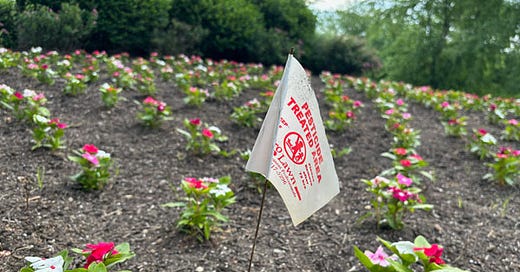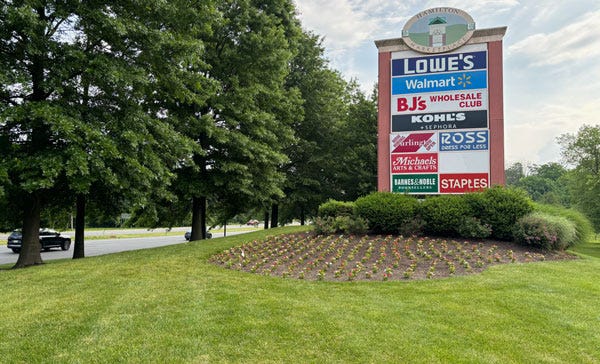Our Chemical Industrial Complex
Weed killers, antibacterial soap, and the indiscriminate murder of civilians
Welcome to another edition of Willoughby Hills!
This newsletter explores topics like history, culture, work, urbanism, transportation, travel, agriculture, self-sufficiency, and more.
Last weekend at this time, I was waking up in the parking lot of a Cracker Barrel in New Jersey, having parked overnight in our RV. I’ve written before about the strange paradox of our RV: it’s wasteful on fuel and dependent on interstates, but it also allows us to rediscover nature in unexpected ways.
This is especially pronounced since we got our dog a year and a half ago. Before him, we might park somewhere to spend the night and never set foot outside. But these days, every time we stop, I end up taking him around wherever we are to use the bathroom and get some exercise.
As I was walking our dog around the edge of the Cracker Barrel parking lot last weekend, I stumbled upon the sign for the shopping center that was adjacent to where we were parked.
The sign itself wasn’t anything remarkable, although its placement seemed a bit odd. The main road (where the black SUV is seen in the above photo) was four lanes wide (two in each direction) and probably had a speed limit of 35 or 40 miles per hour. There was a large stand of tall oak trees separating the road from the sign, making it difficult to even see from a car.
Perhaps the strangest detail to me was a bed of freshly planted flowers surrounded by mulch sitting at the base of the sign. Considering that traffic was speeding by and this lawn area wasn’t super accessible to the public, I wondered who the flowers were supposed to be for, and even more importantly, why such effort was put into planting them at all, when most people wouldn’t even notice them.
But even more odd than the bed of flowers themselves was a little white flag amongst the mulch that said “Pesticide Treated Area” encouraging people and pets to stay away for 72 hours.
Again, questioning the logic and choices of this flower bed, I wondered now not only who willed it into existence, but why they felt the need to treat this area with harmful chemicals that nobody can see and nobody can access (except perhaps dog walkers wandering from Cracker Barrel).
In that moment, I realized this little flower bed and that little white flag seemed to represent so much about our modern world, and in particular, America’s view on life.
Since at least World War II, we have had the technology and the capacity to wipe away life forms big and small. And we do it constantly and indiscriminatley. So much so that we don’t even notice it’s happening.
Yes, we nuked Japan twice. But we also nuke our flower beds, our farms, our hands, and our bodies constantly.
At one time, we understood that bugs were just a part of nature and we used natural remedies to prevent them from destroying our gardens. We planted fragrant plants that repelled certain insects. We planted other flowers to attract ladybugs, which would eat problematic insects. When we spray pesticides indiscriminately, we kill the good and the bad bugs, including those ladybugs, honeybees, and more.
The same goes for weeds. Many farmers grew sick of weeding and industry presented a solution. Buy genetically modified seeds from Monsanto that are designed to resist herbicides like glyphosate. Farmers can then spray their entire fields with glyphosate and kill anything green that isn’t one of these speciality crops.
These days, 89% of all corn, cotton, and soybeans grown in the U.S. are these genetically modified versions. Imagine as you drive through the midwest and see acres upon acres of cornfields just how much glyphosate and other harmful herbicides and pesticides are being sprayed around you!
Chemical giant Monsanto not only profits from selling Roundup, the brand name version of glyphosate, but they also sell the genetically modified seeds. Many of these seeds are patented, so farmers are not allowed to save seed from year to year. Instead, they must go to Monsanto to purchase new ones every year.
Roundup is also sold for use around our yards at hardware stores and garden centers across the country. But it doesn’t mean that everybody is in favor of its usage.
I remember Roundup being on the set of This Old House exactly one time during my 15 years there. Our landscape contractor Roger Cook was using it sparingly to directly target grass that was growing amongst creeping juniper along a homeowner’s hillside. Roger advocated using gloves with it and demonstrated how he used a paintbrush to selectively apply it only to the blades of grass that were problematic. This was early on in my career there, but Roger’s stressing of the dangers of glyphosate and how it should be carefully used as a last resort to target one specific plant left an impression on me.
The World Health Organization has deemed glyphosate a likely carcinogen, yet farmers continue to spray it on our fields and onto crops that we eat, and homeowners buy it by the gallon to treat their gardens, walkways, and patios.
We not only indiscriminately kill the plants and insects around us, we also kill the microbes that live on our bodies all the time. Chemicals like antibacterial soaps and hand sanitizer have gained widespread usage because the thought of having bacteria or other microbes on our bodies is, well, icky.
As I discussed on the podcast a few years ago with Dr. Steven Gundry, we have just begun to learn more about the human microbiome over the past decade or so, which are the trillions of microscopic organisms living in and on our bodies. The good microbes play an important role in digestion and in keeping our bodies healthy.
There are of course bad microbes too, but when we use strong soaps and chemical products, we are indiscriminately killing both good and bad microbes.
I have become conscious of this and try to avoid using antibacterial soaps and hand sanitizers whenever possible. That’s not to say I’m unclean. I still wash my hands after using the bathroom, before cooking food, and before eating. But I try to rely on more natural soaps that can wash away dirt and things that might make me sick without washing away the good microbes too.
Consuming medicine like antibiotics also kill off not only whatever is making us sick, but also many of the healthy parts of our microbiome, so I try to avoid antibiotics unless absolutely necessary. I also regularly eat foods that boost a healthy microbiome, like sauerkraut.
Some doctors are aware of the connection between medicine and possible adverse health effects, but many more still recommend heavy prescription drugs as the solution to any problem. I believe part of this is because of the influence of Big Pharma on both the curriculum taught in medical schools, and also the continued lobbying by pharmaceutical sales reps at doctors’ offices throughout their practicing years.
Dr. Gundry also discussed this connection on my podcast (lightly edited):
“If you look actually at the board of directors of most major medical schools, most major agribusinesses and most pharmaceutical companies, they all intertwine. And it's actually shocking that these three pillars would co-mingle. And in a way, sickness is really good for lots of businesses.
The German word for hospital is krankenhaus, sick house. You used to go to the hospital because you were sick. Now we have these sprawling health care systems that the last thing they're interested in is health.”
When you have a society that is okay, and even profits from, the indiscriminate killing of microbes, insects, and plants, is it any wonder that we’re watching the indiscriminate massacre of tens of thousands of Palestinians in Gaza right now?
It’s the same pattern we’ve seen in U.S. wars again and again. The United States lost about 7,000 soldiers and 8,000 contractors during the Post-9/11 wars in Iraq and Afghanistan. Compare that to 177,000 uniformed Afghans, Pakistanis and Iraqis and Syrian allies. But the true cost of those wars, including indirect deaths that were the result of famine, environmental damage, or trauma is cited at closer to 4.6 million people. Whether microbes or humans, it’s indiscriminate killing.
As I’ve written about before, this style of massacre is nothing new. It happened to my own people in the Philippines during World War II and it continues to happen around the world at the hands of the U.S. military.
When Eisenhower warned about the Military Industrial Complex, I think he was mainly thinking about companies that manufactured tanks, guns, and other weapons for direct use by the military. But that definition should also include the chemical companies that have created chemical weapons that can be rebranded and sold stateside as solutions to lawn and garden problems.
Thanks for reading Willoughby Hills! Subscribe for free to receive new posts and support my work.
Related Reading
The Thanksgiving Play and Memorial Day
If you’ve missed past issues of this newsletter, they are available to read here.







One other point about those flowers is that as annuals they will be pulled out and trashed at the end of the season so the next seasonal annual can be planted as infinitum.
My husband is a geriatric medicine doctor. He routinely takes new patients off the majority of the meds other providers have prescribed and just keep refilling without much thought as to whether the med is still necessary. He almost always gets tremendous pushback from the patient and/or caregiver. Patients demanding prescriptions, especially antibiotics, is another issue for many providers, especially with the increase of pharmaceutical advertising on TV in in print media.
There are wedding and death industrial complexes, plus many others, because in the US, capitalism is woven into everything. Never let a crisis go unexploited. We recently had some carpenter ants moving into our house because there were gaps along the lowest level of siding and. Several slices of lemon placed along the ant trails coupled with caulk to close the gaps sent them elsewhere & stopped their invasion. Of course, pest control option involved 10x the cost with a 1 minute phone call, but with only a 3 month warranty, and no strategic solution to plug the gaps that attracted - and would continue to attract
- the carpenter ants. There are often lower cost, less invasive techniques. However, their duration may consume more time and developed countries' residents expect instant results.